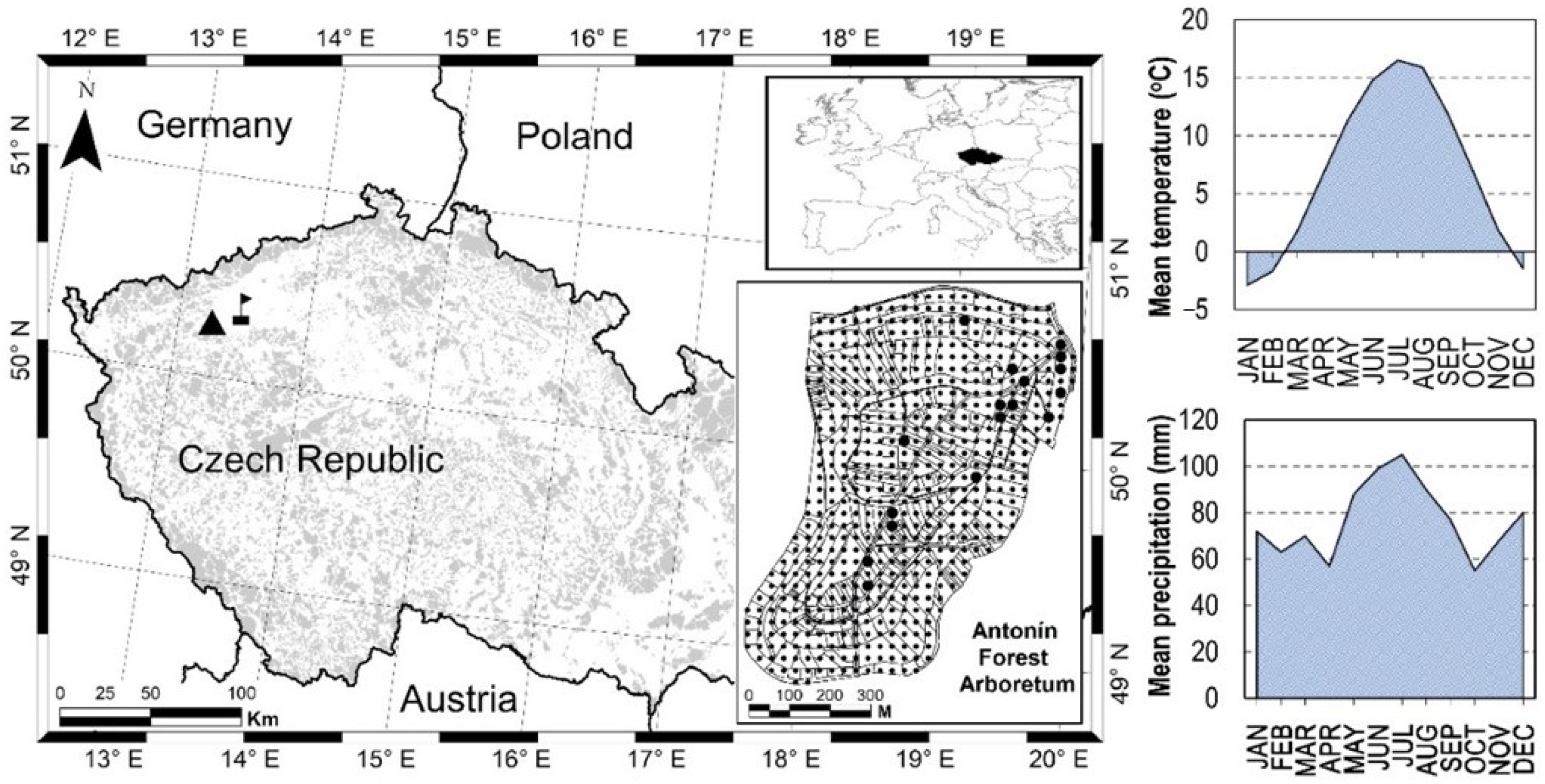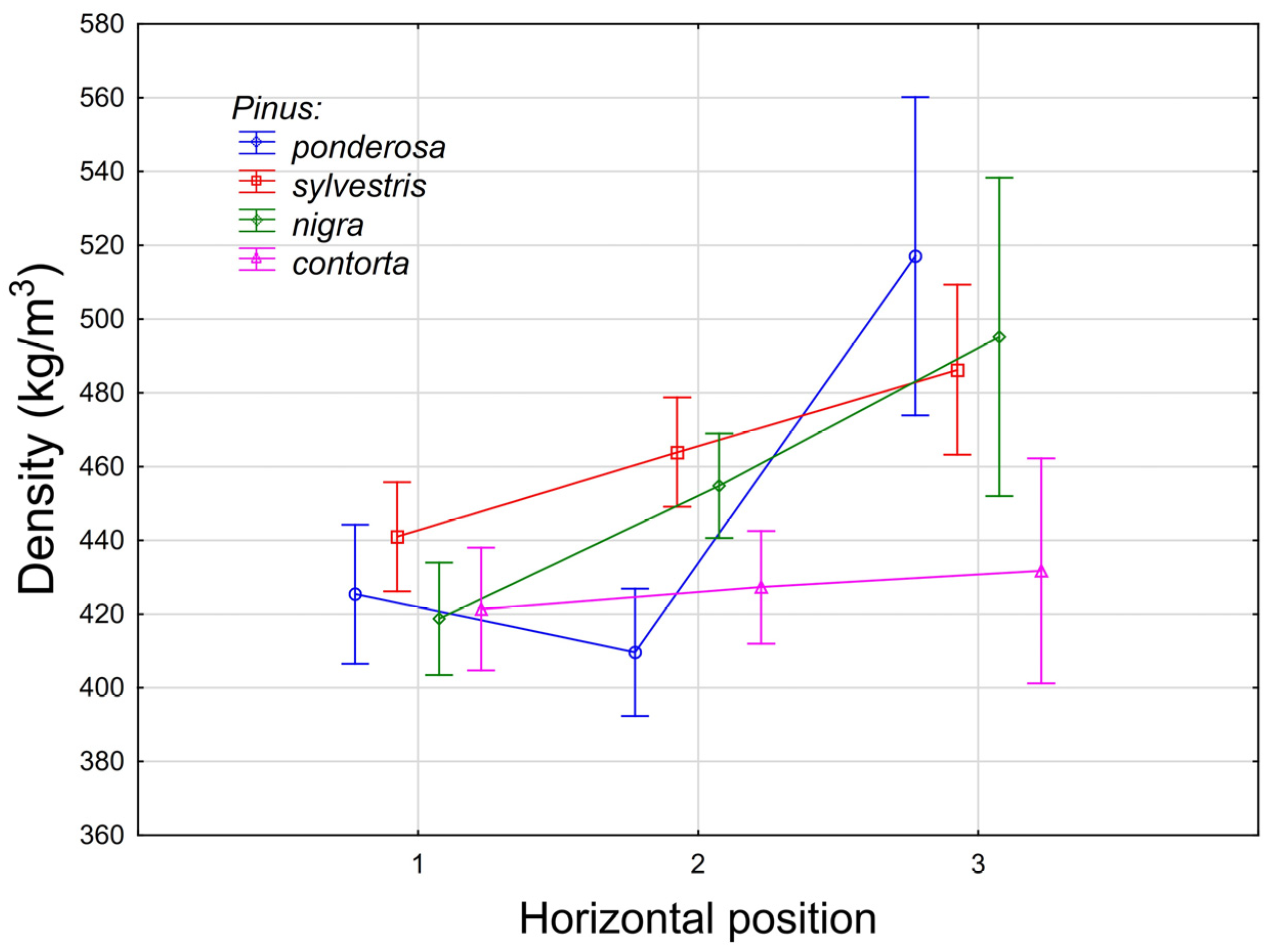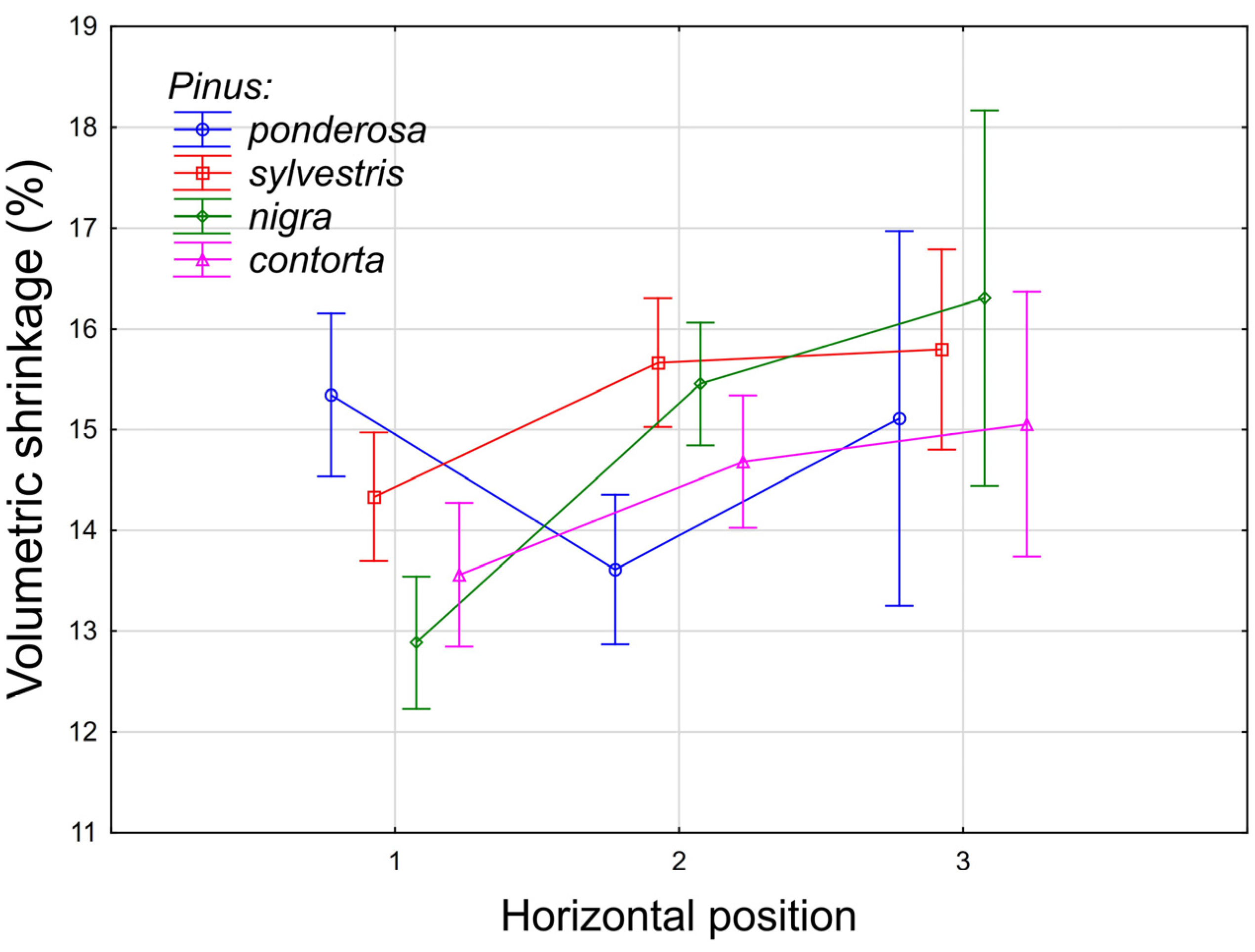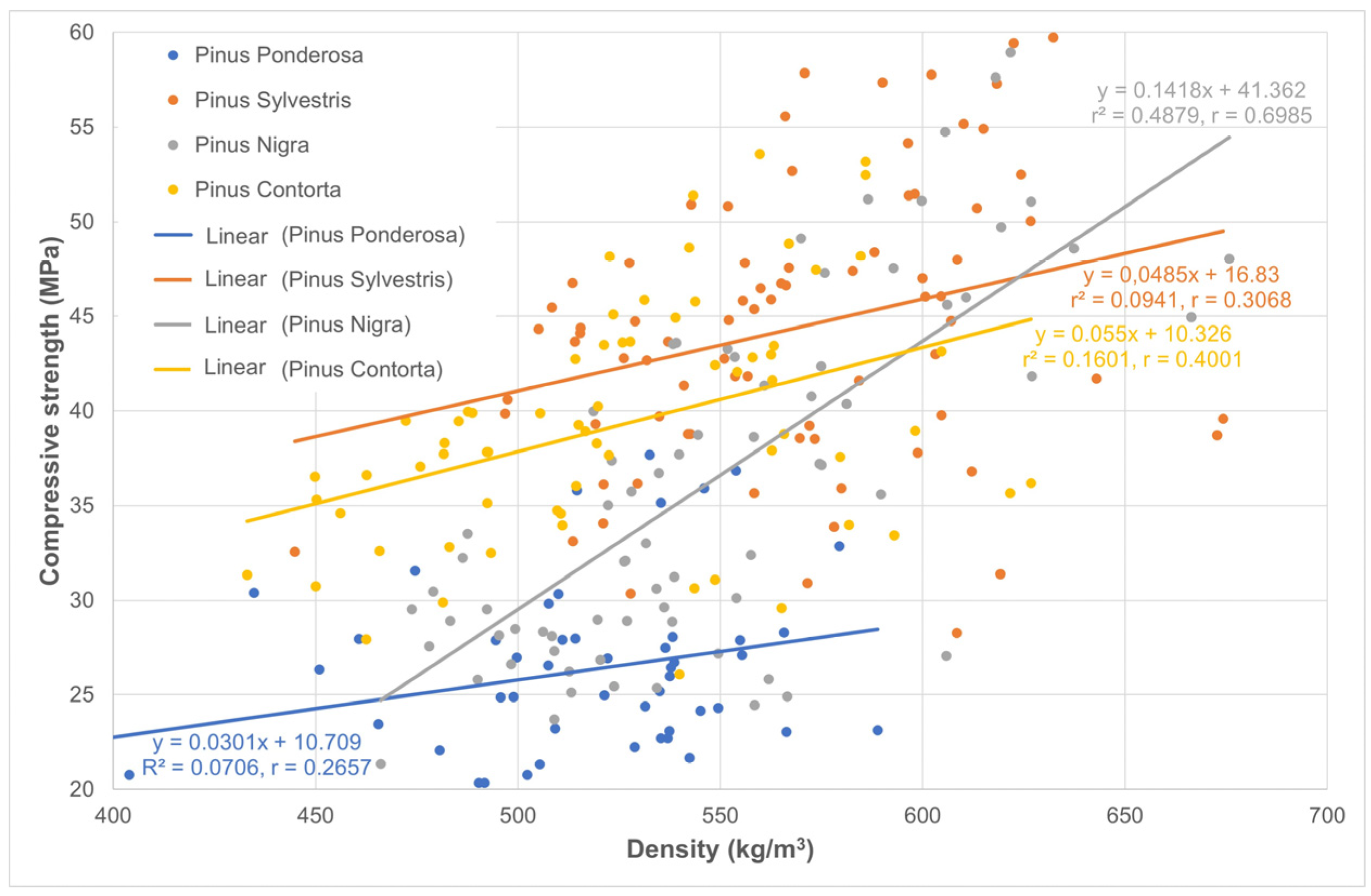The Potential of Non-Native Pines for Timber Production—A Case Study from Afforested Post-Mining Sites
Abstract
1. Introduction
2. Materials and Methods
2.1. Study Area
2.2. Data Collection and Determination of Properties
2.3. Data Analysis
3. Results
3.1. Production Potential
3.2. Wood Density
3.3. Volumetric Shrinkage
3.4. Compressive Strength
3.5. Relationships among the Properties
4. Discussion
5. Conclusions
Author Contributions
Funding
Data Availability Statement
Acknowledgments
Conflicts of Interest
References
- Grimm, N.B.; Grove, J.M.; Pickett, S.T.; Redman, C.L. Integrated Approaches to Long-Term Studies of Urban Ecological Systems. In Urban Ecology; Marzluff, J.M., Ed.; Springer: Boston, MA, USA, 2008. [Google Scholar] [CrossRef]
- Lanz, B.; Dietz, S.; Swanson, T. The Expansion of Modern Agriculture and Global Biodiversity Decline: An Integrated Assessment. Ecol. Econ. 2018, 144, 260–277. [Google Scholar] [CrossRef]
- Olofsson, P.; Kuemmerle, T.; Griffiths, P.; Knorn, J.; Baccini, A.; Gancz, V.; Blujdea, V.; Houghton, R.A.; Abrudan, I.V.; Woodcock, C.E. Carbon Implications of Forest Restitution in Post-Socialist Romania. Environ. Res. Lett. 2011, 6, 045202. [Google Scholar] [CrossRef]
- Riggio, J.; Baillie, J.E.M.; Brumby, S.; Ellis, E.; Kennedy, C.M.; Oakleaf, J.R.; Tait, A.; Tepe, T.; Theobald, D.M.; Venter, O.; et al. Global Human Influence Maps Reveal Clear Opportunities in Conserving Earth’s Remaining Intact Terrestrial Ecosystems. Glob. Chang. Biol. 2020, 26, 4344–4356. [Google Scholar] [CrossRef] [PubMed]
- Kaplan, J.O.; Krumhardt, K.M.; Zimmermann, N. The Prehistoric and Preindustrial Deforestation of Europe. Quat. Sci. Rev. 2009, 28, 3016–3034. [Google Scholar] [CrossRef]
- Williams, M. Dark Ages and Dark Areas: Global Deforestation in the Deep Past. J. Hist. Geogr. 2000, 26, 28–46. [Google Scholar] [CrossRef]
- Keenan, R.J.; Reams, G.A.; Achard, F.; de Freitas, J.V.; Grainger, A.; Lindquist, E. Dynamics of Global Forest Area: Results from the FAO Global Forest Resources Assessment 2015. For. Ecol. Manag. 2015, 352, 9–20. [Google Scholar] [CrossRef]
- Cukor, J.; Vacek, Z.; Vacek, S.; Linda, R.; Podrázský, V. Biomass Productivity, Forest Stability, Carbon Balance, and Soil Transformation of Agricultural Land Afforestation: A Case Study of Suitability of Native Tree Species in the Submontane Zone in Czechia. Catena 2022, 210, 105893. [Google Scholar] [CrossRef]
- Jepsen, M.R.; Kuemmerle, T.; Müller, D.; Erb, K.; Verburg, P.H.; Haberl, H.; Vesterager, J.P.; Andrič, M.; Antrop, M.; Austrheim, G.; et al. Transitions in European Land-Management Regimes between 1800 and 2010. Land Use Policy 2015, 49, 53–64. [Google Scholar] [CrossRef]
- Kolecka, N.; Kozak, J. Wall-to-Wall Parcel-Level Mapping of Agricultural Land Abandonment in the Polish Carpathians. Land 2019, 8, 129. [Google Scholar] [CrossRef]
- Yang, D.; Zhang, H.; Wang, Z.; Zhao, S.; Li, J. Changes in Anthropogenic Particulate Matters and Resulting Global Climate Effects since the Industrial Revolution. Int. J. Climatol. 2022, 42, 315–330. [Google Scholar] [CrossRef]
- Wadanambi, R.T.; Wandana, L.S.; Chathumini, K.K.G.L.; Dassanayake, N.P.; Preethika, D.D.P.; Arachchige, U.S. The effects of industrialization on climate change. J. Res. Technol. Eng. 2020, 1, 86–94. [Google Scholar]
- Kauppi, P.E.; Stål, G.; Arnesson-Ceder, L.; Hallberg Sramek, I.; Hoen, H.F.; Svensson, A.; Wernick, I.K.; Högberg, P.; Lundmark, T.; Nordin, A. Managing Existing Forests Can Mitigate Climate Change. For. Ecol. Manag. 2022, 513, 120186. [Google Scholar] [CrossRef]
- Coomes, D.A.; Flores, O.; Holdaway, R.; Jucker, T.; Lines, E.R.; Vanderwel, M.C. Wood Production Response to Climate Change Will Depend Critically on Forest Composition and Structure. Glob. Chang. Biol. 2014, 20, 3632–3645. [Google Scholar] [CrossRef] [PubMed]
- Zeidler, A.; Borůvka, V.; Brabec, P.; Tomczak, K.; Bedřich, J.; Vacek, Z.; Cukor, J.; Vacek, S. The Possibility of Using Non-Native Spruces for Norway Spruce Wood Replacement—A Case Study from the Czech Republic. Forests 2024, 15, 255. [Google Scholar] [CrossRef]
- Tomczak, K.; Kopacz, J.; Jelonek, T.; Tomczak, A. Wood Quality of Silver Birch (Betula Pendula Roth.) Stands Growing on Post-Agricultural Sites. Sylwan 2023, 167, 427–439. [Google Scholar]
- Tomczak, K.; Mania, P.; Tomczak, A. Quality of Beech, Birch and Oak Wood from Stands Growing on Post-Agricultural Lands. Wood Res. 2023, 68, 279–292. [Google Scholar] [CrossRef]
- Tost, M.; Murguia, D.; Hitch, M.; Lutter, S.; Luckeneder, S.; Feiel, S.; Moser, P. Ecosystem Services Costs of Metal Mining and Pressures on Biomes. Extr. Ind. Soc. 2020, 7, 79–86. [Google Scholar] [CrossRef]
- Kubát, J. History and Present Situation on Reclamation of Spoil Banks in the Sokolov Region. Sci. Agric. Bohem. 2008, 39, 342–347. [Google Scholar]
- Kupka, I.; Dimitrovský, K. Test Results of Selected Tree Species for Forestry Reclamations in the Sokolov Region. Zprávy Lesn. Výzkumu 2011, 56, 52–56. [Google Scholar]
- Pietrzykowski, M. Macronutrient Accumulation and Relationships in a Scots Pine (Pinus sylvestris L.) Ecosystem on Reclaimed Opencast Lignite Mine Spoil Heaps in Central Poland. In Proceedings of the 25th Annual Meeting of American Society of Mining and Reclamation (ASMR), “New Opportunities to Apply Our Science”, Richmond, VA, USA, 14–19 June 2008; pp. 856–877. [Google Scholar]
- Dutta, R.K.; Agrawal, M. Litterfall, Litter Decomposition and Nutrient Release in Five Exotic Plant Species Planted on Coal Mine Spoils. Pedobiologia 2001, 45, 298–312. [Google Scholar] [CrossRef]
- Horodecki, P.; Jagodziński, A.M. Tree Species Effects on Litter Decomposition in Pure Stands on Afforested Post-Mining Sites. For. Ecol. Manag. 2017, 406, 1–11. [Google Scholar] [CrossRef]
- Bungart, R.; Bens, O.; Hüttl, R.F. Production of Bioenergy in Post-Mining Landscapes in Lusatia: Perspectives and Challenges for Alternative Landuse Systems. Ecol. Eng. 2000, 16, 5–16. [Google Scholar] [CrossRef]
- Güngör, E.; Şen, G. Sustainable Afforestation Strategies: Hybrid Multi-Criteria Decision-Making Model in Post-Mining Rehabilitation. Forests 2024, 15, 783. [Google Scholar] [CrossRef]
- Davis, V.; Burger, J.A.; Rathfon, R.A.; Zipper, C.E.; Miller, C.R. Selecting Tree Species for Reforestation of Appalachian Mined Lands; Appalachian Regional Reforestation Initiative Location: Merrifield, VA, USA, 2012. [Google Scholar]
- Pietrzykowski, M.; Woś, B.; Pająk, M. Ecological Restoration of Degraded Soils through Protective Afforestation. In Agroecological Approaches for Sustainable Soil Management; Wiley: Hoboken, NJ, USA, 2023; pp. 145–163. [Google Scholar]
- Vacek, Z.; Cukor, J.; Vacek, S.; Gallo, J.; Bažant, V.; Zeidler, A. Role of Black Pine (Pinus Nigra J. F. Arnold) in European Forests Modified by Climate Change. Eur. J. For. Res. 2023, 142, 1239–1258. [Google Scholar] [CrossRef]
- UNECE; FAO. State of Europe’s Forests 2015; Ministerial Conference on the Protection of Forests in Europe FOREST EUROPE Liaison Unit Madrid: Madrid, Spain, 2015. [Google Scholar]
- Spasić, M.; Vacek, O.; Vejvodová, K.; Tejnecký, V.; Vokurková, P.; Križová, P.; Polák, F.; Vašát, R.; Borůvka, L.; Drábek, O. Which Trees Form the Best Soil? Reclaimed Mine Soil Properties under 22 Tree Species: 50 Years Later—Assessment of Physical and Chemical Properties. Eur. J. For. Res. 2024, 143, 561–579. [Google Scholar] [CrossRef]
- Vacek, Z.; Vacek, S.; Cukor, J. European Forests under Global Climate Change: Review of Tree Growth Processes, Crises and Management Strategies. J. Environ. Manag. 2023, 332, 117353. [Google Scholar] [CrossRef] [PubMed]
- Brichta, J.; Vacek, S.; Vacek, Z.; Cukor, J.; Mikeska, M.; Bílek, L.; Šimůnek, V.; Gallo, J.; Brabec, P. Importance and Potential of Scots Pine (Pinus sylvestris L.) in 21 St Century. Cent. Eur. For. J. 2023, 69, 3–20. [Google Scholar] [CrossRef]
- Durrant, T.H.; de Rigo, D.; Caudullo, G. Pinus Sylvestris in Europe: Distribution, Habitat, Usage and Threats. Eur. Atlas For. Tree Species 2016, 14, 845–846. [Google Scholar]
- Bose, A.K.; Gessler, A.; Büntgen, U.; Rigling, A. Tamm Review: Drought-Induced Scots Pine Mortality—Trends, Contributing Factors, and Mechanisms. For. Ecol. Manag. 2024, 561, 121873. [Google Scholar] [CrossRef]
- Lemaire, J.; Vennetier, M.; Prévosto, B.; Cailleret, M. Interactive Effects of Abiotic Factors and Biotic Agents on Scots Pine Dieback: A Multivariate Modeling Approach in Southeast France. For. Ecol. Manag. 2022, 526, 120543. [Google Scholar] [CrossRef]
- Cukor, J.; Vacek, Z.; Linda, R.; Vacek, S.; Šimůnek, V.; Macháček, Z.; Brichta, J.; Prokůpková, A. Scots Pine (Pinus sylvestris L.) Demonstrates a High Resistance against Bark Stripping Damage. For. Ecol. Manag. 2022, 513, 120182. [Google Scholar] [CrossRef]
- Vacek, Z.; Cukor, J.; Vacek, S.; Podrázský, V.; Linda, R.; Kovařík, J. Forest Biodiversity and Production Potential of Post-Mining Landscape: Opting for Afforestation or Leaving It to Spontaneous Development? Cent. Eur. For. J. 2018, 64, 116–126. [Google Scholar] [CrossRef]
- Koppen, W. Das Geographische System de Klimate. Handb. Der Klimatol. 1936. [Google Scholar]
- ČSN 49 0108; Drevo. Zisťovanie Hustoty (Wood. Determination of the Density). Český Normalizační Institut: Prague, Czech Republic, 1993. (In Czech)
- ČSN 490128; Metóda Zistovania Zosýchavosti. (Determination of Shrinkage). Úrad pro Normalizaci a Merení: Praha, Czech Republic, 1989. (In Czech)
- ČSN 49 0103; Drevo. Zisťovanie Vlhkosti Pri Fyzikálnych a Mechanických Skúškach (Wood. Determination of Moisture Content at Physical and Mechanical Testing). Vydavatelství Úřadu pro Normalizaci a Měření: Prague, Czech Republic, 1979. (In Czech)
- ČSN 49 0110; Drevo. Medza Pevnosti v Tlaku v Smere Vlákien (Wood. Compression Strength Limits Parallel to the Grain). Office for Standardization and Measurement: Prague, Czech Republic, 1980. (In Czech)
- Crookston, N.L. Percent Canopy Cover and Stand Structure Statistics from the Forest Vegetation Simulator; US Department of Agriculture, Forest Service, Rocky Mountain Research Station: Fort Collins, CO, USA, 1999.
- Reineke, L.H. Perfecting a Stand-Density Index for Even-Aged Forests. J. Agric. Res. 1933, 46, 627–638. [Google Scholar]
- Halaj, J. Rastove Tabulky Hlavnych Drevin CSSR; Priroda: Ogden, UT, USA, 1987. [Google Scholar]
- Metslaid, S.; Stanturf, J.A.; Hordo, M.; Korjus, H.; Laarmann, D.; Kiviste, A. Growth Responses of Scots Pine to Climatic Factors on Reclaimed Oil Shale Mined Land. Environ. Sci. Pollut. Res. 2016, 23, 13637–13652. [Google Scholar] [CrossRef]
- Vacek, Z.; Cukor, J.; Vacek, S.; Linda, R.; Prokůpková, A.; Podrázský, V. Production Potential, Biodiversity and Soil Properties of Forest Reclamations: Opportunities or Risk of Introduced Coniferous Tree Species under Climate Change? Eur. J. For. Res. 2021, 140, 1243–1266. [Google Scholar] [CrossRef]
- Podrázský, V.; Vacek, Z.; Vacek, S.; Vítámvás, J.; Gallo, J.; Prokůpková, A.; D’Andrea, G. Production Potential and Structural Variability of Pine Stands in the Czech Republic: Scots Pine (Pinus sylvestris L.) vs. Introduced Pines—Case Study and Problem Review. J. For. Sci. 2020, 66, 197–207. [Google Scholar] [CrossRef]
- Vashum, K.T.; Jayakumar, S. Methods to Estimate Above-Ground Biomass and Carbon Stock in Natural Forests—A Review. J. Ecosyst. Ecography 2012, 2, 116. [Google Scholar] [CrossRef]
- Tomczak, A.; Pazdrowski, W.; Jelonek, T. Quality of Scots Pine (Pinus sylvestris L.) Wood Part I. Characteristics of Selected Wood Traits and Properties Affecting Its Quality. Sylwan 2009, 153, 363–372. [Google Scholar]
- Jakubowski, M.; Dobroczyński, M. Allocation of Wood Density in European Oak (Quercus Robur l.) Trees Grown under a Canopy of Scots Pine. Forests 2021, 12, 712. [Google Scholar] [CrossRef]
- Novák, V. Dřevařská Technická Příručka (Wood Handbook); SNTL: Praha, Czech Republic, 1970. [Google Scholar]
- Jelonek, T.; Arasimowicz-Jelonek, M.; Gzyl, J.; Tomczak, A.; Łakomy, P.; Grzywiński, W.; Remlein, A.; Klimek, K.; Kopaczyk, J.; Jaszczak, R.; et al. Influence of Former Farmland on the Characteristics and Properties of Scots Pine (Pinus sylvestris L.) Tree Tissue. BioResources 2019, 14, 3247–3265. [Google Scholar] [CrossRef]
- Repola, J. Models for Vertical Wood Density of Scots Pine, Norway Spruce and Birch Stems, and Their Application to Determine Average Wood Density. Silva Fenn. 2006, 40, 673–685. [Google Scholar] [CrossRef]
- Auty, D.; Achim, A.; Macdonald, E.; Cameron, A.D.; Gardiner, B.A. Models for Predicting Wood Density Variation in Scots Pine. Forestry 2014, 87, 449–458. [Google Scholar] [CrossRef]
- Riesco Munoz, G.; Soilán Canas, M.; Rodríguez Soalleiro, R. Physical Properties of Wood in Thinned Scots Pines (Pinus sylvestris L.) from Plantations in Northern Spain. Ann. For. Sci. 2008, 65, 507. [Google Scholar] [CrossRef]
- Guler, C.; Copur, Y.; Akgul, M.; Buyuksari, U. Some Chemical, Physical and Mechanical Properties of Juvenile Wood from Black Pine (Pinus Nigra Arnold) Plantations. J. Appl. Sci. 2007, 7, 755–758. [Google Scholar] [CrossRef]
- Pazdrowski, W. The Proportion and Some Selected Physical and Mechanical Properties of Juvenile Maturing and Adult Wood of Black Pine and Scots Pine. Electron. J. Pol. Agric. Univ. Ser. For. 2004, 7. [Google Scholar]
- Dias, A.; Gaspar, M.J.; Carvalho, A.; Pires, J.; Lima-Brito, J.; Silva, M.E.; Louzada, J.L. Within- and between-Tree Variation of Wood Density Components in Pinus Nigra at Six Sites in Portugal. Ann. For. Sci. 2018, 75, 58. [Google Scholar] [CrossRef]
- Oliva, A.G.; Merino, V.B.; Seco, J.I.F.-G.; García, M.C.; Prieto, E.H. Effect of Growth Conditions on Wood Density of Spanish Pinus Nigra. Wood Sci. Technol. 2006, 40, 190–204. [Google Scholar] [CrossRef]
- Sable, I.; Grinfelds, U.; Vikele, L.; Rozenberga, L.; Zeps, M.; Neimane, U.; Jansons, A. Effect of Refining on the Properties of Fibres from Young Scots (Pinus sylvestris) and Lodgepole Pines (Pinus contorta). Balt. For. 2017, 23, 529–533. [Google Scholar]
- Vaughan, D.; Auty, D.; Dahlen, J.; Sánchez Meador, A.J.; Mackes, K.H. Modelling Variation in Wood Stiffness of Pinus Ponderosa Using Static Bending and Acoustic Measurements. For. Int. J. For. Res. 2021, 94, 232–243. [Google Scholar] [CrossRef]
- Alden, H.A. Softwoods of North America; United States Department of Agriculture: Madison, WI, USA, 1997.
- Tsoumis, G. Science and Technology of Wood: Structure, Properties, Utilization; Van Nostrand Reinhold: New York, NY, USA, 1991; Volume 115. [Google Scholar]
- Forest Products Laboratory. Wood Handbook—Wood as an Engineering Material. General Technical Report FPL-GTR-190; Department of Agriculture, Forest Service, Forest Products Laboratory: Madison, WI, USA, 2010.
- Skaar, C. Wood-Water Relations; Springer: Berlin/Heidelberg, Germany, 1988. [Google Scholar]
- Shmulsky, R.; Jones, P.D. Forest Products and Wood Science An Introduction; Wiley: Hoboken, NJ, USA, 2011; ISBN 9780813820743. [Google Scholar]
- Farsi, M.; Kiaei, M.; Miar, S.; Kiasari, S.M. Effect of Seed Source on Physical Properties of Scots Pine (a Case Study in Neka, Iran). Drv. Ind. 2013, 64, 183–191. [Google Scholar] [CrossRef]
- Wagenführ, R. Holzatlas, Wood Atlas; Fachbuchverlag: Leipzig, Germany, 2007. [Google Scholar]
- Schönfelder, O.; Zeidler, A.; Borůvka, V.; Bílek, L.; Lexa, M. Shrinkage of Scots Pine Wood as an Effect of Different Tree Growth Rates, a Comparison of Regeneration Methods. J. For. Sci. 2018, 64, 271–278. [Google Scholar] [CrossRef]
- Zeidler, A. Selected Wood Properties of Black Pine (Pinus Nigra Arnold.). Zprávy Lesn. Výzkumu 2007, 52, 14–20. [Google Scholar]
- Var, A.A.; Kardaş, I. Changes in Physical, Mechanical, Shrinking and Swelling Properties of Pine Wood Species Treated with Salt Natural Geothermal Waters as Environmentally Safe Resources. Appl. Ecol. Environ. Res. 2019, 17, 14053–14068. [Google Scholar] [CrossRef]
- Jelonek, T.; Pazdrowski, W.; Tomczak, A. Selected Properties of Wood in Scots Pine (Pinus sylvestris L.) Growing on Post-Agricultural Land in Northern Poland. For. Res. Pap. 2009, 70, 277–286. [Google Scholar] [CrossRef]
- Wąsik, R.; Michalec, K.; Barszcz, A.; Mudryk, K. Variability of selected macrostructure features, density and compression strength along the grain of the “Tabórz” Scots pine wood (Pinus sylvestris L.). Drewno. Pr. Nauk. Doniesienia Komun. = Wood. Res. Pap. Rep. Announc. 2020, 63, 171–182. [Google Scholar] [CrossRef]
- Panshin, A.J.; De Zeeuw, C. Textbook of Wood Technology: Structure, Identification, Properties, and Uses of the Commercial Woods of the United States and Canada; McGraw-Hill: New York, NY, USA, 1980. [Google Scholar]
- Schimleck, L.R.; Dahlen, J.; Auty, D. Radial Patterns of Specific Gravity Variation in North American Conifers. Can. J. For. Res. 2022, 52, 889–900. [Google Scholar] [CrossRef]
- Hayatgheibi, H. Quantitative Genetics of Lodgepole Pine (Pinus contorta) Wood Quality Traits in Sweden. Acta Univ. Agric. Sueciae 2018, 63, 171–182. [Google Scholar]
- Zobel, B.J.; Van Buijtenen, J.P. Wood Variation: Its Causes and Control; Springer Science & Business Media: Berlin/Heidelberg, Germany, 2012; ISBN 3642740693. [Google Scholar]
- Vaughan, D.; Auty, D.; Kolb, T.; Dahlen, J.; Sánchez Meador, A.J.; Mackes, K.H. Wood Density Variation in Naturally Regenerated Stands of Pinus Ponderosa in Northern Arizona, USA. Can. J. For. Res. 2021, 51, 583–594. [Google Scholar] [CrossRef]
- Dinwoodie, J.M.J. Timber: Its Nature and Behaviour, 2nd ed.; Routledge: New York, NY, USA, 2000; ISBN 1135808104. [Google Scholar]
- Dias, A.; Carvalho, A.; Silva, M.E.; Lima-Brito, J.; Gaspar, M.J.; Alves, A.; Rodrigues, J.C.; Pereira, F.; Morais, J.; Lousada, J.L. Physical, Chemical and Mechanical Wood Properties of Pinus Nigra Growing in Portugal. Ann. For. Sci. 2020, 77, 72. [Google Scholar] [CrossRef]
- Fernandes, C.; Gaspar, M.; Pires, J.; Alves, A.; Simões, R.; Rodrigues, J.; Silva, M.; Carvalho, A.; Brito, J.; Lousada, J. Physical, Chemical and Mechanical Properties of Pinus Sylvestris Wood at Five Sites in Portugal. iForest Biogeosci. For. 2017, 10, 669–679. [Google Scholar] [CrossRef]
- Mackes, K.; Shepperd, W.; Jennings, C. Evaluating the Bending Properties of Clear Wood Specimens Produced from Small-Diameter Ponderosa Pine Trees. For. Prod. J. 2005, 55, 72. [Google Scholar]
- Siau, J.F. Transport Processes in Wood; Springer: Berlin/Heidelberg, Germany, 1984; Volume 2, ISBN 978-3-642-69215-4. [Google Scholar]
- Leonardon, M.; Altaner, C.M.; Vihermaa, L.; Jarvis, M.C. Wood Shrinkage: Influence of Anatomy, Cell Wall Architecture, Chemical Composition and Cambial Age. Eur. J. Wood Wood Prod. 2010, 68, 87–94. [Google Scholar] [CrossRef]







| PRP | dbh | h | f | V | HDR | MAI | SDI | CC |
|---|---|---|---|---|---|---|---|---|
| (cm) | (m) | (m3 ha−1) | (m3 ha−1 yr−1) | (%) | ||||
| Pinus sylvestris | 18.9 a ± 1.1 | 17.95 b ± 1.09 | 0.452 ab ± 0.003 | 376 b ± 55 | 94.8 b ± 1.0 | 8.18 b ± 1.20 | 1.04 b ± 0.09 | 86.4 b ± 1.1 |
| Pinus nigra | 15.5 a ± 0.6 | 14.76 a ± 0.51 | 0.439 a ± 0.006 | 256 ab ± 35 | 95.4 b ± 4.0 | 5.54 ab ± 0.78 | 0.98 b ± 0.13 | 87.3 b ± 2.4 |
| Pinus concorta | 20.8 a ± 0.8 | 13.92 a ± 0.79 | 0.473 bc ± 0.007 | 157 a ± 35 | 66.7 a ± 2.1 | 3.37 a ± 0.72 | 0.52 a ± 0.08 | 69.1 a ± 5.6 |
| Pinus ponderosa | 23.6 a ± 8.2 | 13.73 a ± 4.65 | 0.486 c ± 0.147 | 335 ab ± 122 | 61.2 a ± 20.1 | 7.05 ab ± 2.53 | 1.01 ab ± 0.28 | 90.6 b ± 25.7 |
| test | KW | ANOVA | KW | ANOVA | ANOVA | ANOVA | ANOVA | KW |
| p-value | 0.086 | 0.046 | <0.001 | 0.043 | <0.001 | 0.038 | 0.011 | 0.005 |
| Tree Species | Mean | Min. | Max. | SD | CV |
|---|---|---|---|---|---|
| Pinus ponderosa | 425 a ± 7.6 | 371 | 727 | 54 | 12.6 |
| Pinus sylvestris | 458 b ± 5.1 | 356 | 602 | 46 | 10.0 |
| Pinus nigra | 441 a,b ± 4.4 | 385 | 530 | 38 | 8.6 |
| Pinus contorta | 425 a ± 6.2 | 348 | 730 | 51 | 12.0 |
| Tree Species | Mean | Min. | Max. | SD | CV |
|---|---|---|---|---|---|
| Pinus ponderosa | 14.4 a ± 0.3 | 9.7 | 19.4 | 2.3 | 16.3 |
| Pinus sylvestris | 15.1 a ± 0.3 | 9.0 | 18.9 | 2.3 | 15.1 |
| Pinus nigra | 14.4 a ± 0.2 | 10.5 | 19.2 | 1.9 | 13.5 |
| Pinus contorta | 14.3 a ± 0.2 | 8.6 | 18.0 | 1.7 | 11.7 |
| Tree Species | Mean | Min | Max | SD | CV |
|---|---|---|---|---|---|
| Pinus ponderosa | 26.2 a ± 0.7 | 17.7 | 37.7 | 4.6 | 17.6 |
| Pinus sylvestris | 44.2 c ± 0.8 | 28.3 | 59.7 | 7.2 | 16.2 |
| Pinus nigra | 36.5 b ± 1.1 | 21.3 | 61.7 | 9.7 | 26.6 |
| Pinus contorta | 39.3 b ± 0.8 | 26.1 | 53.6 | 6.2 | 15.8 |
Disclaimer/Publisher’s Note: The statements, opinions and data contained in all publications are solely those of the individual author(s) and contributor(s) and not of MDPI and/or the editor(s). MDPI and/or the editor(s) disclaim responsibility for any injury to people or property resulting from any ideas, methods, instructions or products referred to in the content. |
© 2024 by the authors. Licensee MDPI, Basel, Switzerland. This article is an open access article distributed under the terms and conditions of the Creative Commons Attribution (CC BY) license (https://creativecommons.org/licenses/by/4.0/).
Share and Cite
Zeidler, A.; Borůvka, V.; Tomczak, K.; Vacek, Z.; Cukor, J.; Vacek, S.; Tomczak, A. The Potential of Non-Native Pines for Timber Production—A Case Study from Afforested Post-Mining Sites. Forests 2024, 15, 1388. https://doi.org/10.3390/f15081388
Zeidler A, Borůvka V, Tomczak K, Vacek Z, Cukor J, Vacek S, Tomczak A. The Potential of Non-Native Pines for Timber Production—A Case Study from Afforested Post-Mining Sites. Forests. 2024; 15(8):1388. https://doi.org/10.3390/f15081388
Chicago/Turabian StyleZeidler, Aleš, Vlastimil Borůvka, Karol Tomczak, Zdeněk Vacek, Jan Cukor, Stanislav Vacek, and Arkadiusz Tomczak. 2024. "The Potential of Non-Native Pines for Timber Production—A Case Study from Afforested Post-Mining Sites" Forests 15, no. 8: 1388. https://doi.org/10.3390/f15081388
APA StyleZeidler, A., Borůvka, V., Tomczak, K., Vacek, Z., Cukor, J., Vacek, S., & Tomczak, A. (2024). The Potential of Non-Native Pines for Timber Production—A Case Study from Afforested Post-Mining Sites. Forests, 15(8), 1388. https://doi.org/10.3390/f15081388









